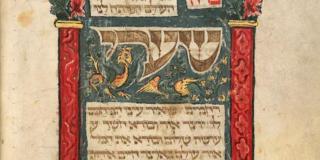
Amulets from Jewish Tombs in Irbid, Jordan
Unknown creator
Inscribed Amulets from Jewish Tombs in Irbid, Jordan
Gold and silver
ca. 4th–7th centuries
These protective amulets, dated between the 4th and 7th centuries and discovered in Jewish tombs in Irbid, are the most ancient Judaica items in the Library’s collections. They provide a rare window into the world of daily lives, beliefs, and traditions of Jews in the period of late antiquity. The amulets were made of small, thin, rolled sheets of durable metals such as gold and silver, and were engraved in Aramaic (below) and Greek (above). Originally kept in capsules, they were intended for extended wear on the body to guard it from evil spirits and other hazards, during life and even after death.
Mary Anna Draper (1839–1914), a well-known astronomer and antiquities collector, donated the amulets to the Library in 1907. She had acquired them from a dealer who participated in the archaeological excavations around Irbid, a town in modern-day Jordan. Upon discovery, they were flattened and placed into small glazed frames for examination and study.
This object can be displayed in an image on the exhibition website. Use the Official Image field to upload an image. Use the Copyright Status as the Official Image Rights Statement. If present in your search result, Use the Copyright Notice as the Official Image Copyright Notice.






